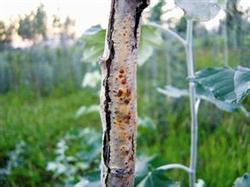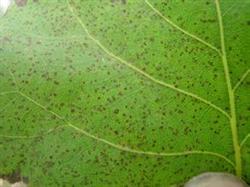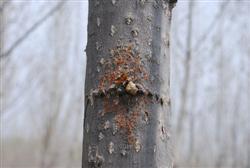Skin rot of poplar and its control methods

Skin rot, also known as rot, is mainly distributed in Northeast, Northwest and North China. It mainly harms the branches of trees and is highly contagious. once the disease is prevalent, it often causes a large area of forest death and great losses. In recent years, due to the large-scale planting of poplar, the disease occurs from time to time in various places. A single poplar variety planting will create conditions for the occurrence of the disease. If there is no strict prevention and control, it may occur. Prevention and control methods: 1. Multi-variety forest planting in the region, if a single development of poplar varieties, is not conducive to disease control and control, multi-planting mixed forest (such as poplar thorn mixed), is not conducive to the spread of diseases. two。 A large area of poplar forest, every certain distance (such as 400 meters) to set Robinia pseudoacacia or elm isolation forest belt, has the role of hindering the spread of bacteria, once the disease can be done regional control, will not be all infected. If the poplar forest is small, you can also set up an isolated forest belt around it. 3. When planting trees, we should pay attention to suitable trees, select disease-resistant varieties, and use excellent seedlings with qualified experience and asepsis. Reduce root injury when raising seedlings, avoid water loss and trauma in the process of transportation, and pay attention to protect seedlings and reduce damage when planting. Strengthen the tending and management of young forests, such as weeding, loosening soil, wiping buds, timely drainage and irrigation, prohibition of grazing, prevention and control of diseases and insect pests, etc. Pruning should be carried out in winter and try to avoid pruning in the rainy season. 4. White tree trunks in late autumn or early spring to prevent frost cracking, sunburn, disease and insect control. 5. The competent forestry authorities in areas where conditions or diseases are likely to occur shall uniformly organize the removal of diseased branches and diseased trees in autumn and winter. All diseased trees and branches that have been cleared will be burned to eliminate the source of bacteria. Forest owners should conduct self-examination at any time in spring and summer, find diseased plants and branches, and remove and destroy them in time. By giving priority to prevention in this way, the loss can be controlled in a small range. 6. This disease is easy to occur in the old nursery or the nursery changed after the vegetable protected area for many years. If the disease is found, the stubble should be changed and other varieties other than willow should be planted on this land. Soil disinfection and poplar cuttings disinfection should be carried out before raising seedlings. 7. For young trees with trunk disease and no germs found in the roots, stubble treatment can be carried out and disinfected with chemicals (such as 50% carbendazim). When treating the affected part of the adult tree disease, first use a knife to dig out all the disease spots, expose the xylem, disinfect with chemicals, and apply 10% alkali water or 25 times carbendazim or topiramate.
- Prev

Identification and Control of Brown spot of Poplar
Poplar brown spot is a common leaf disease, which mainly harms Populus tomentosa, Populus tomentosa, steamed bread willow and so on. At the initial stage of the disease, there are small yellow-brown spots on the surface, which gradually expand, the edge color is lighter and neat, to the later stage, the center of the lesion becomes brown, and there are black spots on it. After the black spot breaks, the conidia are released and blown by the wind.
- Next

The rot disease of poplar and its control
Poplar is a general name for deciduous trees of the genus Populus in the family Populus. There are more than 100 species in all genera, mainly distributed in temperate zone, cold zone, Mediterranean coastal countries and Middle East in Europe, Asia and North America. There are more than 50 species in China. Wood is used as civil building materials, producing furniture, matchsticks, sawn timber, paper, etc., but also man-made.
Related
- Fuxing push coffee new agricultural production and marketing class: lack of small-scale processing plants
- Jujube rice field leisure farm deep ploughing Yilan for five years to create a space for organic food and play
- Nongyu Farm-A trial of organic papaya for brave women with advanced technology
- Four points for attention in the prevention and control of diseases and insect pests of edible fungi
- How to add nutrient solution to Edible Fungi
- Is there any good way to control edible fungus mites?
- Open Inoculation Technology of Edible Fungi
- Is there any clever way to use fertilizer for edible fungus in winter?
- What agents are used to kill the pathogens of edible fungi in the mushroom shed?
- Rapid drying of Edible Fungi

